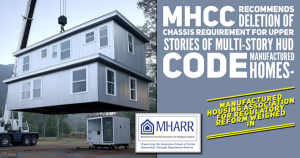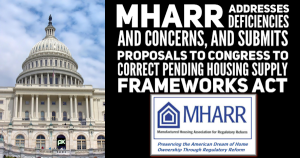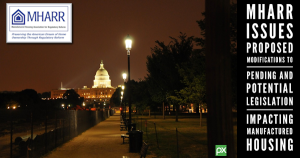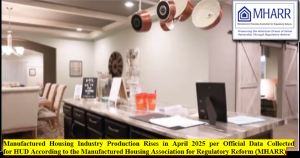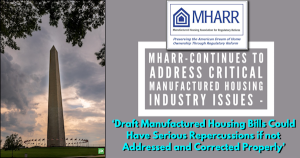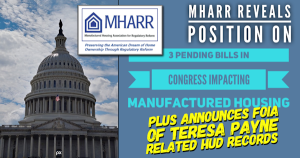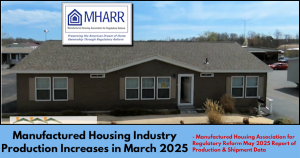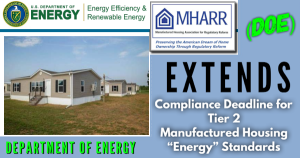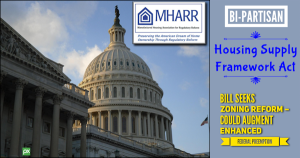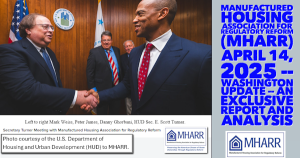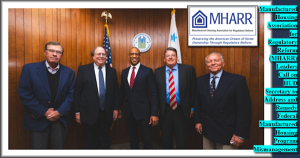Manufactured Housing Enters the Biden Era
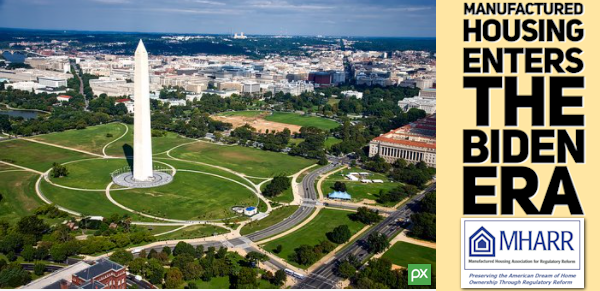
REPORT AND ANALYSIS
IN THIS REPORT: FEBRUARY 2, 2021
- BIDEN FOCUSES ON ACCESS TO AFFORDABLE HOUSING
- BIDEN RESCINDS TRUMP REGULATORY ORDERS
- FHFA DTS DECISION AT ODDS WITH BIDEN HOUSING POLICIES
- HUD ZONING STUDY OFF TRACK BEFORE IT STARTS
- MHARR STRONGLY SUPPORTS STATE ROLE IN HUD PROGRAM
- HUD ISSUES “THIRD” SET OF NEW AND REVISED MH STANDARDS
- DOE WITHDRAWS GAS FURNACE RULE OPPOSED BY MHARR
- MHARR WELCOMES INCOMING HUD SECRETARY
BIDEN INTENSIFIES FOCUS ON AFFORDABLE HOUSING
President Biden, in an Executive Memorandum issued on January 26, 2021, has set out policies designed to intensify the federal government’s commitment to ensuring affordable housing opportunities for lower and moderate-income Americans, and particularly groups that have suffered from “systemic barriers to safe, accessible and affordable housing,” including “people of color, immigrants [and] individuals with disabilities,” among other people in need of affordable housing. MHARR distributed a copy of this memorandum on January 27, 2021 and noted that it would provide a further analysis of the President’s policy directive in relation to federally-regulated manufactured housing. That analysis, as further detailed below, indicates that while the substantive goals of federal housing policy have not changed significantly with this new directive, major differences in the approach, pace, and forcefulness of the implementation of those goals within the Department of Housing and Urban Development are likely going forward. With these changes, MHARR will recalibrate its approach to all aspects of federal policy pertaining to manufactured housing, in order to advance key objectives under the industry’s two good federal laws – laws that for too long have been hijacked, twisted, distorted, and misappropriated to benefit corporate conglomerates and more affluent constituencies, rather than people in need of affordable housing as specifically identified by President Biden.
At the outset, despite cosmetic differences in presentation and emphasis, it is important to recognize that thesubstantive character of the Biden Administration’s housing policy is not significantly different from that of the Trump Administration – i.e., ensuring the greatest possible availability of affordable housing, homeownership, and related home financing for Americans in need of affordable housing. This fundamental goal directly aligns with the unique strengths and abilities of the HUD Code manufactured housing industry and with the objectives and interests of the industry’s smaller, independent businesses, as represented by MHARR. The key difference between the two administrations, by contrast, is likely to inhere in the nature and degree of effective implementation of those policies, particularly within HUD. President Trump, for his part, as a private business executive before becoming president, had a tendency to delegate policy implementation to agency personnel without forceful or effective follow-up and oversight. As a result, many good policy initiatives were either scuttled, distorted, or endlessly delayed by institutional resistance within agency bureaucracies (see, articles below). President Biden, on the other hand, as a long-time Washington, D.C. veteran and insider, knows how the federal bureaucracy functions and can reasonably be expected to put in place the type of oversight necessary to ensure that administration policies are actually implemented for the benefit of people in need of affordable housing.
Just as importantly, the timing of these changes in the implementation of policies designed to help people in need of affordable housing, could not be better for the industry’s small businesses and for the lower and moderate-income Americans who rely the most on affordable, mainstream manufactured housing. Despite the fact that the industry today is building its best homes ever, access for many Americans to the industry’s mainstream affordable homes has either been totally blocked or severely diminished by zoning laws that discriminatorily exclude manufactured housing from many areas of the country and by the absence of federal support for the vast bulk of the industry’s consumer financing. And while good laws designed to remedy these issues have been enacted by Congress – i.e., the enhanced preemption provision of the Manufactured Housing Improvement Act of 2000 and the Duty to Serve (DTS) provision of the Housing and Economic Recovery Act of 2008 (HERA) – those laws have either been ignored or knowingly subverted to serve the interests of powerful corporate conglomerates rather than people in need of affordable housing (see, article below, “New DTS Plans Backtrack on Chattel Loan Support”). Now, though, with an intensified emphasis and focus on the availability of affordable homeownership for people actually in need of that homeownership, rather than corporate oligarchs or wealthier homebuyers, the true objectives of those laws can and must be realized after far too many false starts and failures.
Put differently, manufactured housing has always been economically available as a housing option for virtually all Americans due to its inherent affordability. Now it is time to make manufactured housing practically available to all Americans, including those who have previously been excluded from the HUD Code market due to baseless discrimination in local land use mandates, or non-existent federally-based support for manufactured home consumer lending.
Based on the above, MHARR has developed a plan of action to work with the Biden Administration and Congress to help manufactured housing meet not only the objectives of the last two presidential administrations, but also the full purposes and objectives of federal law as set out by Congress in the 2000 reform law. With respect to the Duty to Serve, MHARR will take the lead in opposing and correcting the worsening misuse and abuse of DTS by Fannie Mae, Freddie Mac and their federal regulator, the Federal Housing Finance Agency (FHFA) which seek to direct it away from mainstream, affordable HUD Code manufactured housing and people in need of such genuinely affordable housing, and instead benefit a handful of industry conglomerates and the more affluent consumers that they – i.e., Fannie Mae, Freddie Mac and FHFA would prefer to deal with (see, DTS article below). Similarly, regarding discriminatory and exclusionary zoning and placement edicts, MHARR will intensify its ongoing efforts to utilize not only the enhanced federal preemption of the 2000 reform law, but also the likely-to-be reinvigorated implementation of HUD’s Affirmatively Furthering Fair Housing (AFFH) construct in order to benefit people in need of affordable housing as prioritized by the Biden Administration. Moreover, in all respects, MHARR will rely upon those same Biden Administration priorities to promote fair and reasonable regulatory policies that benefit those same people in need of affordable housing.
Finally, as part of this plan of action, MHARR will now openly identify those within the industry — and some outside — who seek to distort or subvert federal affordable housing policy for their own selfish ends, while diverting or slowing the implementation of the industry’s good laws (e.g., DTS, enhanced federal preemption and the consensus and rulemaking requirements of the 2000 reform law) to benefit the industry’s largest businesses rather than the industry as a whole and Americans in need of affordable housing. All too often in the past, these good laws have been undermined by such actors who make a public show of supporting their full and proper implementation, while actually working behind the scenes for their own ends, thus enabling the dysfunction that has allowed HUD, Fannie Mae, Freddie Mac, FHFA and others to engage in prolonged patterns of misuse and abuse. This has had a substantial cost for both the industry and people in need of affordable housing, which MHARR now plans to expose in an effort to change the status quo and advance genuine, positive change.
MHARR will submit this plan to its Board of Directors at its upcoming meeting, for confirmation and implementation.
BIDEN ADMINISTRATION RESCINDS TRUMP REGULATORY ORDERS
The Biden Administration, in a flurry of executive actions, has dramatically pivoted away from the regulatory reform policies that characterized the administration of former-President Donald Trump. Beyond the new focus of HUD housing policy as set forth in the President’s Executive Memorandum on “Redressing … Discriminatory Housing Practices and Policies” (see, article above), a number of other executive actions, detailed below, will have both direct and indirect impacts on the federal regulation of HUD Code manufactured housing.
Most significantly, a January 20, 2021 Executive Order (EO) entitled “Revocation of Certain Executive Orders Concerning Federal Regulation,” immediately revokes prior Trump Administration EOs which sought to reduce or eliminate burdensome federal regulations on American businesses. This includes, but is not limited to, Executive Order 13771 (“Reducing Regulation and Controlling Regulatory Costs”) and Executive Order 13777 (“Enforcing the Regulatory Reform Agenda”), which together formed the basis for HUD’s so-called “top-to-bottom” review of existing HUD manufactured housing standards and regulations. Although hundreds of reform proposals submitted as part of that “review” were considered, and many were recommended for adoption by the statutory Manufactured Housing Consensus Committee (MHCC) throughout 2019 and early 2020, none were ever finalized or even published by HUD as proposed rules. Given the apparently purposeful delay of these reforms, and with the new Biden Administration EO now in effect, it is highly unlikely that any of the reforms recommended by the MHCC will be enacted.
In addition, the new EO also rescinds Trump Administration EO 13891 (“Promoting the Rule of Law Through Improved Agency Guidance Documents”) and EO 13892 (“Promoting the Rule of Law Through Transparency and Fairness in Civil Administrative Enforcement and Adjudication”), which sought to curb the misuse of sub-regulatory agency “guidance” documents to establish new regulatory burdens in violation of the Administrative Procedure Act (APA) and, in the case of manufactured housing, section 604 of the Manufactured Housing Improvement Act of 2000. As with other Trump Administration reforms, the implementation of these EOs was slowed within HUD during 2019 and 2020, with the result that the only HUD manufactured housing “actions” rescinded through the end of the Trump Administration, were 13 meaningless editions of the Office of Manufactured Housing Programs’ (OMHP) newsletter.
A second action that will affect future manufactured housing standards and regulations and which is related to the Biden Administration housing equity directive detailed above (see, “Biden Intensifies Focus on Affordable Housing”), is an “Executive Memorandum on Modernizing Regulatory Review.” This directive instructs the Office of Management and Budget (OMB) to “provide concrete suggestions on how the regulatory review process can promote public health and safety, economic growth, social welfare, racial justice, environmental stewardship, human dignity, equity, and the interests of future generations.” (Emphasis added). It should be noted that this directive is prospectiveonly. Thus, absent any further steps by the new administration (or Congress), review of this sort will not be applied to existing rules. Nor does this directive alter the purposes or substantive provisions of federal manufactured housing law. Insofar, however, as mainstream HUD Code manufactured housing affirmatively promotes all of the above objectives, this policy statement will become an independent basis for MHARR efforts to preserve, promote defend, maintain, and advance manufactured housing with the new Administration. As a result, MHARR will closely monitor developments relating to this directive and seek opportunities to provide relevant, factual, and accurate input concerning its implementation for the benefit of the entire industry – and specifically its smaller businesses – as well as its consumers.
Finally, the Biden Administration has implemented a temporary regulatory freeze. Under the “Executive Memorandum on Regulatory Freeze Pending Review,” agency heads must pause pending regulatory actions until they are reviewed and approved by a Biden Administration appointee. The “freeze” covers a wide array of regulatory and pseudo-regulatory actions, including “guidance” documents and advance notices of proposed rulemaking. Consequently, this pause will impact activity on HUD’s December 12, 2020 Advance Notice of Proposed Rulemaking concerning payments to the states and possibly could delay slightly the implementation of HUD’s so-called “third set” of manufactured housing standards revisions which are slated to go into effect on March 15, 2021. Beyond these matters, the regulatory pause could also affect other pending actions by HUD or other agencies concerning manufactured housing that have not yet been published in the Federal Register.
Based on all of the above, MHARR maintain that the pending HUD matters affected by the temporary regulatory freeze are fully in accord with the housing policies already set out by the new administration, and need to be reactivated and moved forward quickly.
FHFA HAS EXPLAINING TO DO WITH BIDEN ADMINISTRATION AND
CONGRESS FOR ITS APPROVAL OF FATALLY-FLAWED DTS “PLANS”
The Federal Housing Finance Agency has released revised and updated Duty to Serve Underserved Markets “implementation” plans for both Fannie Mae and Freddie Mac. The plans, as approved by FHFA, contain revisions for 2020 – the final year of the Enterprises’ initial three-year DTS implementation period — as well as provisions extending into 2021. While 2021, based on prior FHFA guidance, was initially targeted to be the first year of a new three-year DTS plan period (i.e., 2021-2023) FHFA, ostensibly due to the COVID-19 pandemic, instead instructed Fannie Mae and Freddie Mac to submit a one-year plan extension proposal for 2021.
Contrary to the affordable housing and affordable housing finance policies just enunciated by the Biden Administration (see, article above, “Biden Intensifies Focus on Affordable Housing”) the modified and updated plans approved by FHFA continue Fannie and Freddie’s unconscionable, baseless and unacceptable retreat from any type of support for the largest single segment of the mainstream manufactured housing market, financed through personal property loans. At the same time, they expand the Enterprises’ ongoing scheme to divert DTS support away from the mainstream HUD Code manufactured homes that serve people in need of affordable housing, and toward more costly hybrid-type homes, from the industry’s largest corporate conglomerates, which serve more affluent buyers.
The new DTS “implementation” plans take a further axe to the Enterprises’ already meager and grossly insufficient proposals regarding the personal property or “chattel” loans that represent nearly 80% of all manufactured home consumer loans. The updated Freddie Mac plan, for example, deletes nearly all of its prior language and commitments to the chattel segment of the market, including all language regarding chattel loan “purchases.” Similarly, Fannie Mae’s revised plan shows no activity in the chattel segment whatsoever, through the end of 2021. Instead, Fannie states that it will “establish outreach and research strategy” for its upcoming “2021-2023 [DTS] plan and potential options for developing future chattel activities.” (Emphasis added). There is no clue or indication, however, as to just when that “future” will arrive. After more than a decade, then, the Enterprises continue to mouth the same timeworn excuses, stating: “We do not have the requisite systems in place to purchase chattel loans, nor do we have historical data on chattel loans performance that would allow us to make determinations about whether the purchases of these loans can be made in a safe and sound manner.” Meanwhile, the Fannie and Freddie revised and updated plans both go to great lengths during the 2021 extension period to further promote and expand their programs for more costly hybrid-type homes that fall outside of the affordable manufactured housing mainstream and benefit the industry’s largest corporate conglomerates, even though they have no “historical data” whatsoever on the performance of such loans, and both programs have landed – once again – with a thud in the marketplace, with only a handful of such loans reported as purchased by Fannie Mae.
Put simply, the non-implementation of DTS within the manufactured housing market, and the attempted diversion of what little activity there is and has been to more costly hybrids, is a disgrace that directly conflicts with the housing policies and priorities of the Biden Administration. Similarly, reports to Congress from FHFA stating that DTS is being implemented within the mainstream, affordable manufactured housing market are an ongoing fraud. Instead of doing what is needed to help credit-worthy lower and moderate-income Americans access safe, decent and affordable manufactured housing, FHFA, Fannie Mae and Freddie Mac are acting as shills for the industry’s largest businesses, and their financial interests. This trajectory, that has made a farce of DTS within the manufactured housing market for more than a decade, must end.
Based on the above, FHFA’s approval of Fannie and Freddie’s baseless, deficient and deceitful DTS “plans,” is squarely at odds with President Biden’s January 26, 2021 housing policy Executive Memorandum which, itself, is fully consistent with Congress’ original intent and objectives with respect to DTS. Therefore, after wasting twelve valuable years there are now many questions that Fannie, Freddie and FHFA should have to answer – preferably at a public hearing – while, at the same time, the existing DTS “plans” are drastically revised to include market-significant securitization support for mainstream manufactured home loans.
HUD DISCRIMINATORY ZONING STUDY STARTS ON WRONG TRACK
MHARR has filed comments with the Office of Management and Budget (OMB) seeking to ensure that a pending HUD study of state and local regulatory barriers to the use and placement of “factory-built” structures is – as it should be — focused specifically and exclusively on discriminatory and exclusionary edicts targeting the availability of affordable, federally-regulated mainstream manufactured housing. MHARR’s comments respond to a December 18, 2020 HUD request for OMB approval of “information collection” relating to such a study.
MHARR specifically sought a HUD study of the negative impacts resulting from discriminatory zoning edicts that either exclude or severely restrict the placement of affordable HUD Code manufactured homes in many communities in an April 4, 2019 meeting with officials of HUD’s Office of Policy Development and Research (PD&R), and in a subsequent April 24, 2019 request to HUD Secretary Ben Carson. MHARR reasoned that a specific study of this type, would be an important step by HUD in connection with MHARR’s effort to advance the full and proper implementation of the enhanced federal preemption provision of the 2000 reform law. Enhanced federal preemption was specifically enacted by Congress to prevent the discriminatory exclusion of manufactured housing via zoning edicts, but has been baselessly ignored by HUD for two decades. The study of “factory-built structures” proposed by HUD in its December 12, 2020 notice, however, rather than “federally-regulated manufactured homes,” will do more to create confusion and chaos than it will to advance the enhanced preemption needed to fight discriminatory zoning laws for the ultimate benefit of American homebuyers.
MHARR thus maintains that the approach proposed by HUD will likely be abused either to wrongfully shift the focus of this information collection and study away from affordable, mainstream HUD code manufactured housing – where it should be – or otherwise skew or undermine its results (and value) by including other types of unrelated, more costly “factory-built” homes that: (1) are not federally-regulated and thus not within HUD’s jurisdiction or authority; (2) are regulated as to construction and safety by state and local codes; and (3) are not subject to the same types of zoning and financing discrimination as mainstream HUD Code manufactured homes and manufactured home consumers. Any such study addressing both HUD Code manufactured homes and other types of factory-built structures, would be like comparing apples to oranges, would needlessly expend tax dollars to examine a problem (i.e., zoning and placement discrimination against non-HUD Code homes) that does not exist, and would not produce the results needed to advance the availability and utilization of affordable, mainstream, federally-regulated manufactured housing.
Unless these serious and, indeed, fatal flaws are corrected by HUD and/or OMB to address – and address only – affordable, mainstream HUD Code manufactured housing, MHARR will have no choice but to oppose this study and its conclusions going forward.
MHARR COMMENTS SUPPORT FULL FUNDING FOR STATES
MHARR, in comments filed with HUD on January 11, 2021, has called on the HUD Office of Manufactured Housing Programs to significantly increase funding for State Administrative Agencies (SAAs) that partner with HUD in carrying out various functions authorized by the National Manufactured Housing Construction and Safety Standards Act of 1974, as amended by the Manufactured Housing Improvement Act of 2000. An increase in HUD program payments to state partners, and a corresponding reduction in HUD payments to – and dependence upon – private contractors, has been a longstanding MHARR priority and was the basis for MHARR’s insistence on language in the 2000 reform law designed to both support state participation and state funding, and simultaneously restrict functions that could be delegated to revenue-driven contractors.
MHARR’s comments, which respond to an Advance Notice of Proposed Rulemaking (ANPR) issued by HUD on November 12, 2020, emphasize the fundamental importance of the federal-state partnership underlying the federal manufactured housing program (one of the most important elements of the 1974 Act), and the urgent need to properly fund that partnership as illustrated by the withdrawal of certain key states – either from the program entirely, or from specific program functions. MHARR’s comments thus seek not only to strengthen existing state participation, but also to encourage new SAAs to be established and to enter the program.
As MHARR’s comments stress, enhanced state funding – and a corresponding reduction in unnecessarily-bloated funding for program contractors – is absolutely necessary insofar as state SAAs are responsible for consumer protection with respect to an ever-growing number of manufactured homes produced since the inception of federal regulation in 1976, while contractors today are responsible for monitoring a much smaller number of current-production homes. Indeed, while state SAA funding has declined by more than 45% since 2005, program contractor funding has increased by more than 167% over the same period, even though only 94,615 homes were produced in 2019, as compared with 146,881 in 2005.
Given the fact that SAAs, as state agencies, have constituencies and a degree of legitimacy that contractors do not have, and were specifically intended by Congress to be part of the regulatory structure of the federal manufactured housing program, SAA participation – and corresponding funding equity – should be an overriding priority for HUD and for OMHP. Accordingly, MHARR’s comments call on HUD to maintain the minimum SAA funding levels required by the 2000 reform law and to further increase SAA funding over and above that statutory floor, to include payments for the performance of specific program functions based on accurate state-by-state information and calculations.
While this proceeding is finally addressing a long-overdue priority, MHARR will continue to press for the full implementation of the 2000 reform law’s provisions regarding proper SAA funding and corresponding limitations on — and reductions of — contractor activities and funding.
HUD ISSUES “THIRD” SET OF NEW AND REVISED STANDARDS
HUD, on January 12, 2021, published, as a final rule, the so-called “third set” of new and revised Federal Manufactured Housing Construction and Safety Standards recommended by the Manufactured Housing Consensus Committee. While these standards, generally supported by MHARR in written comments filed on March 30, 2020, address a number of longstanding industry concerns, including issues prioritized and advanced by MHARR, HUD’s final rule does not address any of the necessary and far-reaching regulatory reform proposals recommended by the MHCC in 2019 and early 2020. The rule, accordingly, is arguably more notable for what it excludes, rather than what it includes.
Among other things, the HUD rule, published in the Federal Register on January 12, 2021, with an effective date of March 15, 2021, establishes new standards for attached garages and carports. Both had been subject of sub-regulatory HUD “guidance” memoranda — which MHARR maintained were unlawful in violation of the 2000 reform law’s mandatory MHCC review and notice and comment requirements — as well as program approval based on the lengthy and unduly burdensome Alternate Construction (AC) process. In addition to these provisions, the January 12, 2021 rule also establishes new requirements for Carbon Monoxide alarms, as well as standards relating to stairways and doors.
Also, among the new standards adopted by the rule, is a new Subpart K of the Part 3280 standards, for “attached” or “zero-lot-line” manufactured homes, defined as “Two or more adjacent manufactured homes that are structurally independent from foundation to roof and with open space on at least two sides, but which have the appearance of a physical connection….” While MHARR, in its written comments, had generally supported this expansion of permissible manufactured home designs, it questioned the motives behind HUD’s sudden impulse to resurrect this particular MHCC proposal, which dates back to 2006, without simultaneously taking action to advance a more significant and more recent proposal advanced by MHARR and recommended by the MHCC, to permit and establish standards for, multi-family manufactured homes – a step that would further cement the statutorily-mandated parity between manufactured homes and site-built homes. While failing to explain why multi-unit, multi-family manufactured home standards could not have been included in the January 12, 2021 final rule, HUD’s preamble notes that “MHCC recommendations for multi-unit manufactured homes are contained in the fourth set of its recommendations for changes to the standards.” MHARR, as a result, will further intensify its efforts to press HUD to propose and adopt standards for such homes, as an essential step in the evolution of today’s modern manufactured housing, and as a step that would be fully consistent with the Biden Administration’s stated focus on improving and expanding housing choices for people in need of affordable housing.
DOE WITHDRAWS FURNACE RULE OPPOSED BY MHARR
The U.S. Department of Energy (DOE), in a notice published in the Federal Register on January 15, 2021, has formally withdrawn two rules proposed in 2015 and 2016 — and opposed by MHARR — that would have imposed costly and destructive energy conservation standards on residential gas furnaces, including furnace types commonly used in manufactured homes. Instead, DOE, in a final interpretive rule published in the same edition of the Federal Register, determined that: “… [I]n the context, of residential furnaces … and similarly-situated products/equipment, [the] use of non-condensing technology (and associated venting) constitute a performance-related ‘feature’ under [the Energy Policy and Conservation Act] that cannot be eliminated through [the] adoption of an energy conservation standard.” As a result, DOE interprets ECPA “to preclude the adoption of energy conservation standards that would limit the market of natural gas, propane gas and/or oil-fired furnaces, water heaters, or similarly-situated covered products/equipment … to appliances that use condensing combustion technology, as that would result in the unavailability of a performance related feature within the meaning of” applicable law. (Emphasis added).
The withdrawal of these rules, which would have significantly and disproportionately impacted HUD Code manufactured homes and manufactured housing consumers, came in response to a natural gas industry coalition petition originally filed in October 2018 and subsequent September 9, 2019 comments filed by members of that same coalition and MHARR, on behalf of manufactured housing producers and industry small businesses.
Insofar as the final interpretive rule (which effectively requires the revocation of the earlier DOE-proposed furnace rules) has an immediate effective date of January 15, 2021 – i.e., prior to the start of the Biden Administration – it does not appear that it will be affected by the Biden Administration’s January 20, 2021 regulatory “freeze” order (see, article above). Nevertheless, MHARR will carefully monitor this matter to address any effort to “claw-back” this revocation.
MHARR WELCOMES HUD SECRETARY-DESIGNATE MARCIA FUDGE
MHARR, in a January 22, 2021 communication, has welcomed Rep. Marcia Fudge (D-OH), President Biden’s nominee to become Secretary of the U.S. Department of Housing and Urban Development. Congresswoman Fudge, who has represented a district in the Cleveland, Ohio area for seven terms, comes to HUD with a deep understanding of the housing needs of lower and moderate-income Americans and the urgent need to expand access to affordable housing and homeownership, such as that provided by mainstream, affordable manufactured homes.
MHARR looks forward to Rep. Fudge’s confirmation as HUD Secretary and the opportunity to work with her and other Biden Administration appointees at HUD, to advance the availability and utilization of mainstream, affordable manufactured housing in all areas of the United States.
REPORT AND ANALYSIS
IN THIS REPORT: FEBRUARY 2, 2021
- BIDEN FOCUSES ON ACCESS TO AFFORDABLE HOUSING
- BIDEN RESCINDS TRUMP REGULATORY ORDERS
- FHFA DTS DECISION AT ODDS WITH BIDEN HOUSING POLICIES
- HUD ZONING STUDY OFF TRACK BEFORE IT STARTS
- MHARR STRONGLY SUPPORTS STATE ROLE IN HUD PROGRAM
- HUD ISSUES “THIRD” SET OF NEW AND REVISED MH STANDARDS
- DOE WITHDRAWS GAS FURNACE RULE OPPOSED BY MHARR
- MHARR WELCOMES INCOMING HUD SECRETARY
BIDEN INTENSIFIES FOCUS ON AFFORDABLE HOUSING
President Biden, in an Executive Memorandum issued on January 26, 2021, has set out policies designed to intensify the federal government’s commitment to ensuring affordable housing opportunities for lower and moderate-income Americans, and particularly groups that have suffered from “systemic barriers to safe, accessible and affordable housing,” including “people of color, immigrants [and] individuals with disabilities,” among other people in need of affordable housing. MHARR distributed a copy of this memorandum on January 27, 2021 and noted that it would provide a further analysis of the President’s policy directive in relation to federally-regulated manufactured housing. That analysis, as further detailed below, indicates that while the substantive goals of federal housing policy have not changed significantly with this new directive, major differences in the approach, pace, and forcefulness of the implementation of those goals within the Department of Housing and Urban Development are likely going forward. With these changes, MHARR will recalibrate its approach to all aspects of federal policy pertaining to manufactured housing, in order to advance key objectives under the industry’s two good federal laws – laws that for too long have been hijacked, twisted, distorted, and misappropriated to benefit corporate conglomerates and more affluent constituencies, rather than people in need of affordable housing as specifically identified by President Biden.
At the outset, despite cosmetic differences in presentation and emphasis, it is important to recognize that thesubstantive character of the Biden Administration’s housing policy is not significantly different from that of the Trump Administration – i.e., ensuring the greatest possible availability of affordable housing, homeownership, and related home financing for Americans in need of affordable housing. This fundamental goal directly aligns with the unique strengths and abilities of the HUD Code manufactured housing industry and with the objectives and interests of the industry’s smaller, independent businesses, as represented by MHARR. The key difference between the two administrations, by contrast, is likely to inhere in the nature and degree of effective implementation of those policies, particularly within HUD. President Trump, for his part, as a private business executive before becoming president, had a tendency to delegate policy implementation to agency personnel without forceful or effective follow-up and oversight. As a result, many good policy initiatives were either scuttled, distorted, or endlessly delayed by institutional resistance within agency bureaucracies (see, articles below). President Biden, on the other hand, as a long-time Washington, D.C. veteran and insider, knows how the federal bureaucracy functions and can reasonably be expected to put in place the type of oversight necessary to ensure that administration policies are actually implemented for the benefit of people in need of affordable housing.
Just as importantly, the timing of these changes in the implementation of policies designed to help people in need of affordable housing, could not be better for the industry’s small businesses and for the lower and moderate-income Americans who rely the most on affordable, mainstream manufactured housing. Despite the fact that the industry today is building its best homes ever, access for many Americans to the industry’s mainstream affordable homes has either been totally blocked or severely diminished by zoning laws that discriminatorily exclude manufactured housing from many areas of the country and by the absence of federal support for the vast bulk of the industry’s consumer financing. And while good laws designed to remedy these issues have been enacted by Congress – i.e., the enhanced preemption provision of the Manufactured Housing Improvement Act of 2000 and the Duty to Serve (DTS) provision of the Housing and Economic Recovery Act of 2008 (HERA) – those laws have either been ignored or knowingly subverted to serve the interests of powerful corporate conglomerates rather than people in need of affordable housing (see, article below, “New DTS Plans Backtrack on Chattel Loan Support”). Now, though, with an intensified emphasis and focus on the availability of affordable homeownership for people actually in need of that homeownership, rather than corporate oligarchs or wealthier homebuyers, the true objectives of those laws can and must be realized after far too many false starts and failures.
Put differently, manufactured housing has always been economically available as a housing option for virtually all Americans due to its inherent affordability. Now it is time to make manufactured housing practically available to all Americans, including those who have previously been excluded from the HUD Code market due to baseless discrimination in local land use mandates, or non-existent federally-based support for manufactured home consumer lending.
Based on the above, MHARR has developed a plan of action to work with the Biden Administration and Congress to help manufactured housing meet not only the objectives of the last two presidential administrations, but also the full purposes and objectives of federal law as set out by Congress in the 2000 reform law. With respect to the Duty to Serve, MHARR will take the lead in opposing and correcting the worsening misuse and abuse of DTS by Fannie Mae, Freddie Mac and their federal regulator, the Federal Housing Finance Agency (FHFA) which seek to direct it away from mainstream, affordable HUD Code manufactured housing and people in need of such genuinely affordable housing, and instead benefit a handful of industry conglomerates and the more affluent consumers that they – i.e., Fannie Mae, Freddie Mac and FHFA would prefer to deal with (see, DTS article below). Similarly, regarding discriminatory and exclusionary zoning and placement edicts, MHARR will intensify its ongoing efforts to utilize not only the enhanced federal preemption of the 2000 reform law, but also the likely-to-be reinvigorated implementation of HUD’s Affirmatively Furthering Fair Housing (AFFH) construct in order to benefit people in need of affordable housing as prioritized by the Biden Administration. Moreover, in all respects, MHARR will rely upon those same Biden Administration priorities to promote fair and reasonable regulatory policies that benefit those same people in need of affordable housing.
Finally, as part of this plan of action, MHARR will now openly identify those within the industry — and some outside — who seek to distort or subvert federal affordable housing policy for their own selfish ends, while diverting or slowing the implementation of the industry’s good laws (e.g., DTS, enhanced federal preemption and the consensus and rulemaking requirements of the 2000 reform law) to benefit the industry’s largest businesses rather than the industry as a whole and Americans in need of affordable housing. All too often in the past, these good laws have been undermined by such actors who make a public show of supporting their full and proper implementation, while actually working behind the scenes for their own ends, thus enabling the dysfunction that has allowed HUD, Fannie Mae, Freddie Mac, FHFA and others to engage in prolonged patterns of misuse and abuse. This has had a substantial cost for both the industry and people in need of affordable housing, which MHARR now plans to expose in an effort to change the status quo and advance genuine, positive change.
MHARR will submit this plan to its Board of Directors at its upcoming meeting, for confirmation and implementation.
BIDEN ADMINISTRATION RESCINDS TRUMP REGULATORY ORDERS
The Biden Administration, in a flurry of executive actions, has dramatically pivoted away from the regulatory reform policies that characterized the administration of former-President Donald Trump. Beyond the new focus of HUD housing policy as set forth in the President’s Executive Memorandum on “Redressing … Discriminatory Housing Practices and Policies” (see, article above), a number of other executive actions, detailed below, will have both direct and indirect impacts on the federal regulation of HUD Code manufactured housing.
Most significantly, a January 20, 2021 Executive Order (EO) entitled “Revocation of Certain Executive Orders Concerning Federal Regulation,” immediately revokes prior Trump Administration EOs which sought to reduce or eliminate burdensome federal regulations on American businesses. This includes, but is not limited to, Executive Order 13771 (“Reducing Regulation and Controlling Regulatory Costs”) and Executive Order 13777 (“Enforcing the Regulatory Reform Agenda”), which together formed the basis for HUD’s so-called “top-to-bottom” review of existing HUD manufactured housing standards and regulations. Although hundreds of reform proposals submitted as part of that “review” were considered, and many were recommended for adoption by the statutory Manufactured Housing Consensus Committee (MHCC) throughout 2019 and early 2020, none were ever finalized or even published by HUD as proposed rules. Given the apparently purposeful delay of these reforms, and with the new Biden Administration EO now in effect, it is highly unlikely that any of the reforms recommended by the MHCC will be enacted.
In addition, the new EO also rescinds Trump Administration EO 13891 (“Promoting the Rule of Law Through Improved Agency Guidance Documents”) and EO 13892 (“Promoting the Rule of Law Through Transparency and Fairness in Civil Administrative Enforcement and Adjudication”), which sought to curb the misuse of sub-regulatory agency “guidance” documents to establish new regulatory burdens in violation of the Administrative Procedure Act (APA) and, in the case of manufactured housing, section 604 of the Manufactured Housing Improvement Act of 2000. As with other Trump Administration reforms, the implementation of these EOs was slowed within HUD during 2019 and 2020, with the result that the only HUD manufactured housing “actions” rescinded through the end of the Trump Administration, were 13 meaningless editions of the Office of Manufactured Housing Programs’ (OMHP) newsletter.
A second action that will affect future manufactured housing standards and regulations and which is related to the Biden Administration housing equity directive detailed above (see, “Biden Intensifies Focus on Affordable Housing”), is an “Executive Memorandum on Modernizing Regulatory Review.” This directive instructs the Office of Management and Budget (OMB) to “provide concrete suggestions on how the regulatory review process can promote public health and safety, economic growth, social welfare, racial justice, environmental stewardship, human dignity, equity, and the interests of future generations.” (Emphasis added). It should be noted that this directive is prospectiveonly. Thus, absent any further steps by the new administration (or Congress), review of this sort will not be applied to existing rules. Nor does this directive alter the purposes or substantive provisions of federal manufactured housing law. Insofar, however, as mainstream HUD Code manufactured housing affirmatively promotes all of the above objectives, this policy statement will become an independent basis for MHARR efforts to preserve, promote defend, maintain, and advance manufactured housing with the new Administration. As a result, MHARR will closely monitor developments relating to this directive and seek opportunities to provide relevant, factual, and accurate input concerning its implementation for the benefit of the entire industry – and specifically its smaller businesses – as well as its consumers.
Finally, the Biden Administration has implemented a temporary regulatory freeze. Under the “Executive Memorandum on Regulatory Freeze Pending Review,” agency heads must pause pending regulatory actions until they are reviewed and approved by a Biden Administration appointee. The “freeze” covers a wide array of regulatory and pseudo-regulatory actions, including “guidance” documents and advance notices of proposed rulemaking. Consequently, this pause will impact activity on HUD’s December 12, 2020 Advance Notice of Proposed Rulemaking concerning payments to the states and possibly could delay slightly the implementation of HUD’s so-called “third set” of manufactured housing standards revisions which are slated to go into effect on March 15, 2021. Beyond these matters, the regulatory pause could also affect other pending actions by HUD or other agencies concerning manufactured housing that have not yet been published in the Federal Register.
Based on all of the above, MHARR maintain that the pending HUD matters affected by the temporary regulatory freeze are fully in accord with the housing policies already set out by the new administration, and need to be reactivated and moved forward quickly.
FHFA HAS EXPLAINING TO DO WITH BIDEN ADMINISTRATION AND
CONGRESS FOR ITS APPROVAL OF FATALLY-FLAWED DTS “PLANS”
The Federal Housing Finance Agency has released revised and updated Duty to Serve Underserved Markets “implementation” plans for both Fannie Mae and Freddie Mac. The plans, as approved by FHFA, contain revisions for 2020 – the final year of the Enterprises’ initial three-year DTS implementation period — as well as provisions extending into 2021. While 2021, based on prior FHFA guidance, was initially targeted to be the first year of a new three-year DTS plan period (i.e., 2021-2023) FHFA, ostensibly due to the COVID-19 pandemic, instead instructed Fannie Mae and Freddie Mac to submit a one-year plan extension proposal for 2021.
Contrary to the affordable housing and affordable housing finance policies just enunciated by the Biden Administration (see, article above, “Biden Intensifies Focus on Affordable Housing”) the modified and updated plans approved by FHFA continue Fannie and Freddie’s unconscionable, baseless and unacceptable retreat from any type of support for the largest single segment of the mainstream manufactured housing market, financed through personal property loans. At the same time, they expand the Enterprises’ ongoing scheme to divert DTS support away from the mainstream HUD Code manufactured homes that serve people in need of affordable housing, and toward more costly hybrid-type homes, from the industry’s largest corporate conglomerates, which serve more affluent buyers.
The new DTS “implementation” plans take a further axe to the Enterprises’ already meager and grossly insufficient proposals regarding the personal property or “chattel” loans that represent nearly 80% of all manufactured home consumer loans. The updated Freddie Mac plan, for example, deletes nearly all of its prior language and commitments to the chattel segment of the market, including all language regarding chattel loan “purchases.” Similarly, Fannie Mae’s revised plan shows no activity in the chattel segment whatsoever, through the end of 2021. Instead, Fannie states that it will “establish outreach and research strategy” for its upcoming “2021-2023 [DTS] plan and potential options for developing future chattel activities.” (Emphasis added). There is no clue or indication, however, as to just when that “future” will arrive. After more than a decade, then, the Enterprises continue to mouth the same timeworn excuses, stating: “We do not have the requisite systems in place to purchase chattel loans, nor do we have historical data on chattel loans performance that would allow us to make determinations about whether the purchases of these loans can be made in a safe and sound manner.” Meanwhile, the Fannie and Freddie revised and updated plans both go to great lengths during the 2021 extension period to further promote and expand their programs for more costly hybrid-type homes that fall outside of the affordable manufactured housing mainstream and benefit the industry’s largest corporate conglomerates, even though they have no “historical data” whatsoever on the performance of such loans, and both programs have landed – once again – with a thud in the marketplace, with only a handful of such loans reported as purchased by Fannie Mae.
Put simply, the non-implementation of DTS within the manufactured housing market, and the attempted diversion of what little activity there is and has been to more costly hybrids, is a disgrace that directly conflicts with the housing policies and priorities of the Biden Administration. Similarly, reports to Congress from FHFA stating that DTS is being implemented within the mainstream, affordable manufactured housing market are an ongoing fraud. Instead of doing what is needed to help credit-worthy lower and moderate-income Americans access safe, decent and affordable manufactured housing, FHFA, Fannie Mae and Freddie Mac are acting as shills for the industry’s largest businesses, and their financial interests. This trajectory, that has made a farce of DTS within the manufactured housing market for more than a decade, must end.
Based on the above, FHFA’s approval of Fannie and Freddie’s baseless, deficient and deceitful DTS “plans,” is squarely at odds with President Biden’s January 26, 2021 housing policy Executive Memorandum which, itself, is fully consistent with Congress’ original intent and objectives with respect to DTS. Therefore, after wasting twelve valuable years there are now many questions that Fannie, Freddie and FHFA should have to answer – preferably at a public hearing – while, at the same time, the existing DTS “plans” are drastically revised to include market-significant securitization support for mainstream manufactured home loans.
HUD DISCRIMINATORY ZONING STUDY STARTS ON WRONG TRACK
MHARR has filed comments with the Office of Management and Budget (OMB) seeking to ensure that a pending HUD study of state and local regulatory barriers to the use and placement of “factory-built” structures is – as it should be — focused specifically and exclusively on discriminatory and exclusionary edicts targeting the availability of affordable, federally-regulated mainstream manufactured housing. MHARR’s comments respond to a December 18, 2020 HUD request for OMB approval of “information collection” relating to such a study.
MHARR specifically sought a HUD study of the negative impacts resulting from discriminatory zoning edicts that either exclude or severely restrict the placement of affordable HUD Code manufactured homes in many communities in an April 4, 2019 meeting with officials of HUD’s Office of Policy Development and Research (PD&R), and in a subsequent April 24, 2019 request to HUD Secretary Ben Carson. MHARR reasoned that a specific study of this type, would be an important step by HUD in connection with MHARR’s effort to advance the full and proper implementation of the enhanced federal preemption provision of the 2000 reform law. Enhanced federal preemption was specifically enacted by Congress to prevent the discriminatory exclusion of manufactured housing via zoning edicts, but has been baselessly ignored by HUD for two decades. The study of “factory-built structures” proposed by HUD in its December 12, 2020 notice, however, rather than “federally-regulated manufactured homes,” will do more to create confusion and chaos than it will to advance the enhanced preemption needed to fight discriminatory zoning laws for the ultimate benefit of American homebuyers.
MHARR thus maintains that the approach proposed by HUD will likely be abused either to wrongfully shift the focus of this information collection and study away from affordable, mainstream HUD code manufactured housing – where it should be – or otherwise skew or undermine its results (and value) by including other types of unrelated, more costly “factory-built” homes that: (1) are not federally-regulated and thus not within HUD’s jurisdiction or authority; (2) are regulated as to construction and safety by state and local codes; and (3) are not subject to the same types of zoning and financing discrimination as mainstream HUD Code manufactured homes and manufactured home consumers. Any such study addressing both HUD Code manufactured homes and other types of factory-built structures, would be like comparing apples to oranges, would needlessly expend tax dollars to examine a problem (i.e., zoning and placement discrimination against non-HUD Code homes) that does not exist, and would not produce the results needed to advance the availability and utilization of affordable, mainstream, federally-regulated manufactured housing.
Unless these serious and, indeed, fatal flaws are corrected by HUD and/or OMB to address – and address only – affordable, mainstream HUD Code manufactured housing, MHARR will have no choice but to oppose this study and its conclusions going forward.
MHARR COMMENTS SUPPORT FULL FUNDING FOR STATES
MHARR, in comments filed with HUD on January 11, 2021, has called on the HUD Office of Manufactured Housing Programs to significantly increase funding for State Administrative Agencies (SAAs) that partner with HUD in carrying out various functions authorized by the National Manufactured Housing Construction and Safety Standards Act of 1974, as amended by the Manufactured Housing Improvement Act of 2000. An increase in HUD program payments to state partners, and a corresponding reduction in HUD payments to – and dependence upon – private contractors, has been a longstanding MHARR priority and was the basis for MHARR’s insistence on language in the 2000 reform law designed to both support state participation and state funding, and simultaneously restrict functions that could be delegated to revenue-driven contractors.
MHARR’s comments, which respond to an Advance Notice of Proposed Rulemaking (ANPR) issued by HUD on November 12, 2020, emphasize the fundamental importance of the federal-state partnership underlying the federal manufactured housing program (one of the most important elements of the 1974 Act), and the urgent need to properly fund that partnership as illustrated by the withdrawal of certain key states – either from the program entirely, or from specific program functions. MHARR’s comments thus seek not only to strengthen existing state participation, but also to encourage new SAAs to be established and to enter the program.
As MHARR’s comments stress, enhanced state funding – and a corresponding reduction in unnecessarily-bloated funding for program contractors – is absolutely necessary insofar as state SAAs are responsible for consumer protection with respect to an ever-growing number of manufactured homes produced since the inception of federal regulation in 1976, while contractors today are responsible for monitoring a much smaller number of current-production homes. Indeed, while state SAA funding has declined by more than 45% since 2005, program contractor funding has increased by more than 167% over the same period, even though only 94,615 homes were produced in 2019, as compared with 146,881 in 2005.
Given the fact that SAAs, as state agencies, have constituencies and a degree of legitimacy that contractors do not have, and were specifically intended by Congress to be part of the regulatory structure of the federal manufactured housing program, SAA participation – and corresponding funding equity – should be an overriding priority for HUD and for OMHP. Accordingly, MHARR’s comments call on HUD to maintain the minimum SAA funding levels required by the 2000 reform law and to further increase SAA funding over and above that statutory floor, to include payments for the performance of specific program functions based on accurate state-by-state information and calculations.
While this proceeding is finally addressing a long-overdue priority, MHARR will continue to press for the full implementation of the 2000 reform law’s provisions regarding proper SAA funding and corresponding limitations on — and reductions of — contractor activities and funding.
HUD ISSUES “THIRD” SET OF NEW AND REVISED STANDARDS
HUD, on January 12, 2021, published, as a final rule, the so-called “third set” of new and revised Federal Manufactured Housing Construction and Safety Standards recommended by the Manufactured Housing Consensus Committee. While these standards, generally supported by MHARR in written comments filed on March 30, 2020, address a number of longstanding industry concerns, including issues prioritized and advanced by MHARR, HUD’s final rule does not address any of the necessary and far-reaching regulatory reform proposals recommended by the MHCC in 2019 and early 2020. The rule, accordingly, is arguably more notable for what it excludes, rather than what it includes.
Among other things, the HUD rule, published in the Federal Register on January 12, 2021, with an effective date of March 15, 2021, establishes new standards for attached garages and carports. Both had been subject of sub-regulatory HUD “guidance” memoranda — which MHARR maintained were unlawful in violation of the 2000 reform law’s mandatory MHCC review and notice and comment requirements — as well as program approval based on the lengthy and unduly burdensome Alternate Construction (AC) process. In addition to these provisions, the January 12, 2021 rule also establishes new requirements for Carbon Monoxide alarms, as well as standards relating to stairways and doors.
Also, among the new standards adopted by the rule, is a new Subpart K of the Part 3280 standards, for “attached” or “zero-lot-line” manufactured homes, defined as “Two or more adjacent manufactured homes that are structurally independent from foundation to roof and with open space on at least two sides, but which have the appearance of a physical connection….” While MHARR, in its written comments, had generally supported this expansion of permissible manufactured home designs, it questioned the motives behind HUD’s sudden impulse to resurrect this particular MHCC proposal, which dates back to 2006, without simultaneously taking action to advance a more significant and more recent proposal advanced by MHARR and recommended by the MHCC, to permit and establish standards for, multi-family manufactured homes – a step that would further cement the statutorily-mandated parity between manufactured homes and site-built homes. While failing to explain why multi-unit, multi-family manufactured home standards could not have been included in the January 12, 2021 final rule, HUD’s preamble notes that “MHCC recommendations for multi-unit manufactured homes are contained in the fourth set of its recommendations for changes to the standards.” MHARR, as a result, will further intensify its efforts to press HUD to propose and adopt standards for such homes, as an essential step in the evolution of today’s modern manufactured housing, and as a step that would be fully consistent with the Biden Administration’s stated focus on improving and expanding housing choices for people in need of affordable housing.
DOE WITHDRAWS FURNACE RULE OPPOSED BY MHARR
The U.S. Department of Energy (DOE), in a notice published in the Federal Register on January 15, 2021, has formally withdrawn two rules proposed in 2015 and 2016 — and opposed by MHARR — that would have imposed costly and destructive energy conservation standards on residential gas furnaces, including furnace types commonly used in manufactured homes. Instead, DOE, in a final interpretive rule published in the same edition of the Federal Register, determined that: “… [I]n the context, of residential furnaces … and similarly-situated products/equipment, [the] use of non-condensing technology (and associated venting) constitute a performance-related ‘feature’ under [the Energy Policy and Conservation Act] that cannot be eliminated through [the] adoption of an energy conservation standard.” As a result, DOE interprets ECPA “to preclude the adoption of energy conservation standards that would limit the market of natural gas, propane gas and/or oil-fired furnaces, water heaters, or similarly-situated covered products/equipment … to appliances that use condensing combustion technology, as that would result in the unavailability of a performance related feature within the meaning of” applicable law. (Emphasis added).
The withdrawal of these rules, which would have significantly and disproportionately impacted HUD Code manufactured homes and manufactured housing consumers, came in response to a natural gas industry coalition petition originally filed in October 2018 and subsequent September 9, 2019 comments filed by members of that same coalition and MHARR, on behalf of manufactured housing producers and industry small businesses.
Insofar as the final interpretive rule (which effectively requires the revocation of the earlier DOE-proposed furnace rules) has an immediate effective date of January 15, 2021 – i.e., prior to the start of the Biden Administration – it does not appear that it will be affected by the Biden Administration’s January 20, 2021 regulatory “freeze” order (see, article above). Nevertheless, MHARR will carefully monitor this matter to address any effort to “claw-back” this revocation.
MHARR WELCOMES HUD SECRETARY-DESIGNATE MARCIA FUDGE
MHARR, in a January 22, 2021 communication, has welcomed Rep. Marcia Fudge (D-OH), President Biden’s nominee to become Secretary of the U.S. Department of Housing and Urban Development. Congresswoman Fudge, who has represented a district in the Cleveland, Ohio area for seven terms, comes to HUD with a deep understanding of the housing needs of lower and moderate-income Americans and the urgent need to expand access to affordable housing and homeownership, such as that provided by mainstream, affordable manufactured homes.
MHARR looks forward to Rep. Fudge’s confirmation as HUD Secretary and the opportunity to work with her and other Biden Administration appointees at HUD, to advance the availability and utilization of mainstream, affordable manufactured housing in all areas of the United States.

